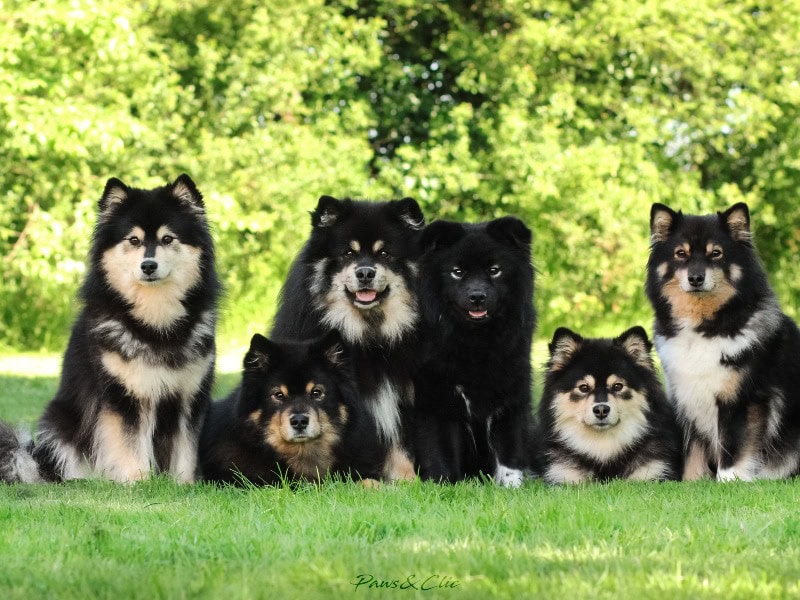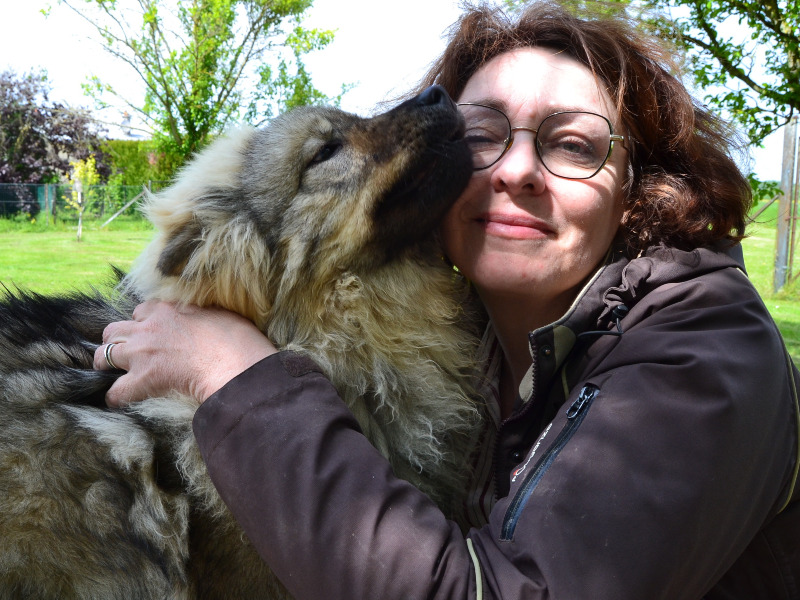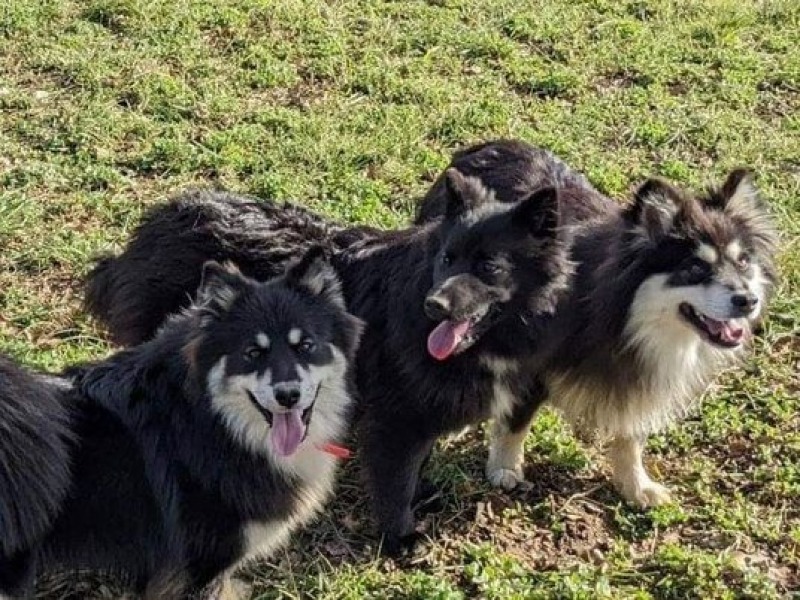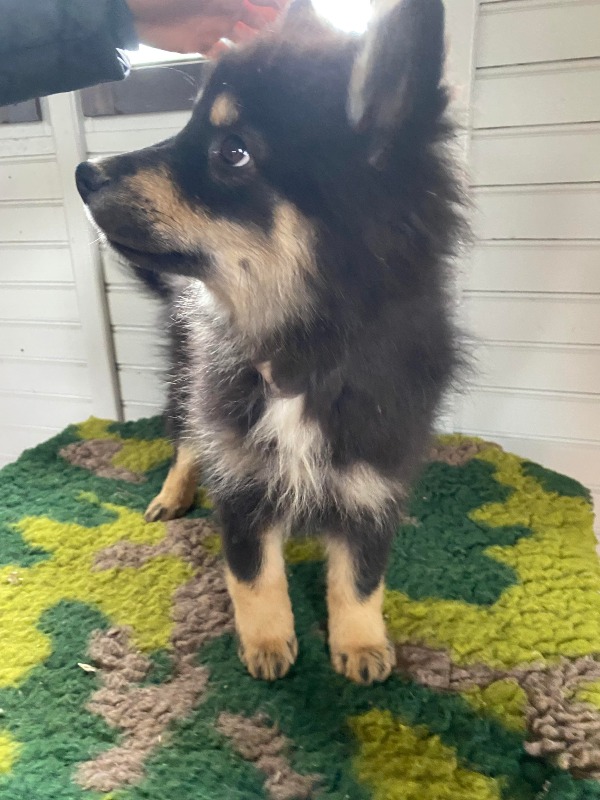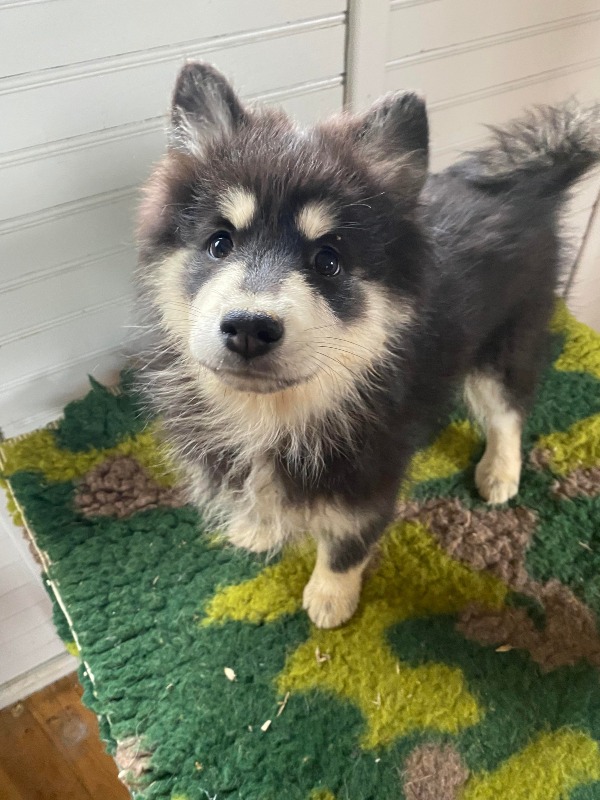Finnish lapphund
Autres noms : Lapinkoira, Suomenlapinkoira, Finnish lapponian dog, Finnish lapphund, Finnischer lapphund, Finse lappenhond, Finnish lapponian dog
Discover the Finnish Lapphund, a majestic and friendly breed known for its intelligence and adaptability. An ideal companion for families, this energetic dog excels in outdoor activities and is characterized by its dense coat and playful temperament.
Awareness of acquiring an animal
Adopting or breeding a dog is a responsibility that must be carefully considered. Dogs are loyal companions that require time, attention, and constant care. Whether for leisure, passion, or professional breeding, it is crucial to understand the specific needs of each breed. Provide them with a loving and stimulating environment, and avoid any impulsive acquisition that could harm their well-being. Be a vigilant and committed owner for a happy and healthy companion.
To learn more about animal welfare, we invite you to consult our FAQ by clicking the button below:
Origins and history
The Finnish Lapphund is a breed originating from Nordic regions, particularly Finland and Lapland. Its ancestors are closely related to the working dogs used by the Sámi people for hunting and reindeer herding. Their adaptability to the harsh climatic conditions of Arctic areas played a key role in the selection of this breed.
These dogs are recognized for their exceptional work instinct and sociability. Over time, they have been bred not only for their agility and endurance but also for their skills as companions. The history of the breed is marked by close interactions with local communities, who valued their loyalty and ability to integrate into traditional lifestyles.
It was in the 1960s that the breed was officially recognized and standardized, leading to a greater structuring of breeding efforts. Today, the Finnish Lapphund is appreciated for both its affectionate nature and its skills as a working dog, particularly in sledding and hunting activities, while maintaining strong ties to its cultural heritage.
Physical characteristics
The Finnish Lapphund is a rustic breed well adapted to the harsh climatic conditions of northern Europe. Medium-sized, this animal typically measures between 48 and 58 cm at the shoulder for males and between 43 and 53 cm for females. Its weight ranges from 15 to 25 kg, giving it a robust silhouette without being heavy.
Its coat is one of its most remarkable characteristics. It has a double layer: a dense and waterproof undercoat that protects it from the cold, and a longer, straighter outer coat. This combination gives it a fluffy and well-furred appearance, especially around the neck and head, where it forms a kind of ruff. The color of its coat can vary, ranging from black to brown, including shades of red and cream, often with white markings.
The face of the Finnish Lapphund is expressive, with almond-shaped eyes that can be brown or amber. Its medium-sized, triangular ears are erect but may slightly fold at the tips. Finally, its thick and well-furred tail is carried curled over the back or to the side, adding to its overall elegant appearance.
Character
The Finnish Lapphund is a breed appreciated for its balanced character and friendly nature. Originating from the northern regions, these dogs are known for their keen intelligence and curiosity. They are often very attached to their human family, developing strong and loyal bonds. This loyalty makes them excellent companions who thrive in a family environment.
Another notable trait of this breed is its cheerful temperament. They are generally playful and love to engage in games, which makes them very interactive. Their energy requires regular and stimulating activities, making them excellent partners for hiking or outdoor play. Furthermore, their sociable nature makes them compatible with other animals as well as with children, bringing a positive dynamic to family life.
Despite their sociability, they can exhibit a certain degree of independence. This autonomy, combined with their intelligence, necessitates an owner who can train them firmly while adopting a positive approach. Patience and consistency are essential for these dogs to flourish as well-mannered pets. In summary, the Finnish Lapphund is a dynamic and endearing breed, ideal for households ready to provide them with love and attention.
Life expectancy
The life expectancy of the Finnish Lapphund typically ranges between 12 and 15 years. This breed is valued for its robust health and relative longevity, which can be attributed to its genetics and history as a working dog. Originating from northern regions, these dogs were bred to hunt and herd reindeer. Their endurance and adaptability to harsh climates also contribute to their resilience.
A key factor influencing life expectancy is the quality of care they receive. A balanced diet, regular exercise, and routine veterinary visits play a crucial role in preventing diseases and maintaining their health. Finnish Lapphunds are prone to developing certain hereditary conditions, but with proper attention, these risks can be managed.
The emotional and mental well-being of these dogs is also essential for their longevity. They require mental stimulation and social interactions, as they are very social animals. An enriching life can significantly impact their quality of life and, consequently, their life expectancy. In conclusion, with proper care, a Finnish Lapphund can live a long and healthy life.
Exercise and activity needs
The Finnish Lappen Dog is an energetic and active breed that requires a significant amount of daily exercise to stay healthy and balanced. A minimum of 60 to 90 minutes of physical activity per day is recommended. This can include walks, runs, and interactive play outdoors, all of which are crucial to satisfy their need for exploration and stimulation.
Exercises in a natural environment are particularly beneficial for this breed, as they allow them to express themselves and expend energy in a setting that suits their instincts. Activities such as hiking, agility, or canicross can be ideal. A varied and enriching environment, these activities promote socialization and learning, while also providing opportunities to work on hunting skills that are rooted in their heritage.
In addition to physical exercise, the Finnish Lappen Dog needs mental stimulation. Games that involve searching, puzzles, and obedience exercises are essential to prevent boredom and the development of destructive behaviors. By combining physical and mental exercise, owners contribute to the overall well-being of their dog, ensuring a happy and active life.
Recommended diet
The Finnish Lapphund is an active and energetic breed that requires a diet tailored to its specific needs. It's essential to provide high-quality food that is rich in proteins and healthy fats to support its activity level and metabolism. Proteins should come from animal sources to ensure good digestibility and an adequate supply of essential amino acids.
Carbohydrates should be included but must come from healthy sources like vegetables and whole grains to provide sustainable energy without causing blood sugar spikes. Avoid foods containing undesirable fillers like corn or soy, as they can harm your dog's digestive health.
It is also important to include omega-3 and omega-6 fatty acids in its diet to promote skin and coat health and to strengthen its immune system. Additionally, vitamin and mineral supplements can be beneficial, especially for growing puppies and older dogs. Lastly, ensure adequate hydration, particularly after physical activities.
Training and obedience
The Finnish Lapphund is a breed that requires a particular approach to education and training. Firstly, it is important to emphasize their intelligence and curiosity, which necessitates varied and stimulating learning methods. The use of positive reinforcement techniques is especially effective for this breed. Rewarding good behaviors with treats or praise helps to establish a climate of trust and motivates the animal.
Next, it is crucial to incorporate exercise and play sessions into their training routine. These dogs, naturally active, enjoy physical activities. Regular walks, scent games, or even sledding activities can not only strengthen the bond between the owner and the dog but also channel their energy.
Finally, socialization is essential for the Finnish Lapphund. It is recommended to expose them from a young age to different environments, people, and other animals. This helps to develop their balanced and calm character. By adopting a patient and consistent approach, it is possible to raise a well-educated and happy companion.
Behavior with children
The Finnish Lapphund is often described as an affectionate and loyal companion, making it a good choice for families with children. Their balanced temperament and friendly nature promote positive interactions with the younger ones. Indeed, these dogs are known for their patience and tolerance, which is essential when young children interact with them.
However, it is crucial to educate children about respecting animals. They must learn to approach the dog calmly and not to disturb it while it is eating or resting. This helps to establish a relationship of trust and mutual respect. Furthermore, the Finnish Lapphund needs early socialization to ensure it develops its interaction skills with children and other animals.
The energetic nature of this breed highlights the importance of exercise and play. Children can be great playmates due to their shared energy. Outdoor activities, such as walks or fetch games, help strengthen the bond between the dog and children while meeting the dog's physical activity needs. In summary, with appropriate supervision and proper education, the coexistence between the Finnish Lapphund and children can be extremely enriching and rewarding.
Compatibility with Other Animals
The Finnish Lapphund is a breed known for its friendly character and balanced temperament. Generally, these dogs are well-suited to family life and get along with other pets. Their pack instinct promotes good socialization with other dogs, whether they are of the same breed or not. When properly introduced, they can live harmoniously with dogs of other breeds.
Regarding cats, compatibility often depends on upbringing and age. A Finnish Lapphund that has been socialized from a young age with felines can get along with them without any issues. However, it is important to monitor their interactions, especially at first, to prevent any signs of predation, particularly in young dogs with a strong hunting instinct.
It is also essential to provide a rich and stimulating environment, as these dogs require physical and mental activity. This can help reduce undesirable behaviors related to boredom or anxiety, thus promoting peaceful cohabitation with other animals. In summary, with proper training and early socialization, the Finnish Lapphund can live in harmony with other pets.
Grooming needs
The Finnish Lapphund is a robust breed that requires regular grooming due to its thick coat and dense undercoat. During shedding periods, typically in spring and autumn, it loses a lot of hair, making frequent brushing essential. Brushing at least once a week is recommended, while during shedding seasons, it may be necessary to do it daily to prevent hair accumulation in the house.
Maintaining the paws is also crucial. The fur between the pads should be regularly trimmed to avoid the buildup of dirt and ice during winter. Additionally, it is important to check and clean the ears to prevent infections, as the breed can be prone to ear problems.
Finally, keeping an eye on dental hygiene is vital. Regular teeth brushing and visits to the veterinarian for dental check-ups will ensure the animal's oral health. In summary, appropriate grooming and maintenance will ensure a healthy and fulfilling life.
Health
The Finnish Lapphund is a robust breed but can be prone to certain health concerns. Generally, this dog is considered healthy, but owners should be aware of several genetic issues.
One major concern is hip dysplasia, a deformity of the joint that can cause pain and arthritis. Regular screenings by specialized veterinarians can help detect this condition from a young age. Be sure to choose a responsible breeder who conducts these tests.
Eye problems, such as cataracts, are also present in the breed. Regular visits to a veterinary ophthalmologist can help prevent serious complications. Finally, Finnish Lapphunds may also suffer from hormonal imbalances, such as hypothyroidism, which can affect their metabolism and energy levels. A balanced diet and regular medical check-ups are crucial for maintaining their health.
Overall, paying attention to preventive health care and maintaining an active lifestyle will help ensure the well-being of this breed.
Environment and habitat
The Finnish Lapphund is a breed native to the Arctic regions, specifically the forested areas and tundras of Lapland. This dog was developed to assist reindeer herders, giving it a strong connection to a harsh natural environment. Its traditional habitat is characterized by long and severe winters, with temperatures often below freezing and abundant snowfall. The breed is well adapted to extreme climatic conditions thanks to its dense and waterproof coat.
In terms of lifestyle, the Finnish Lapphund is a very social animal that requires regular contact with humans and other animals. These dogs thrive in environments where they can be active, whether running in the snow or engaging in outdoor activities. They enjoy open spaces and need sufficient exercise to expend their energy, making them less suited to apartment living without access to a yard or secure areas to move around freely.
Finally, training for this breed must take into account its natural hunting instincts and independent personality. Regular walks and stimulating play are crucial to meet its physical and mental needs. Thus, the ideal environment for a Finnish Lapphund consists of a spacious, active, and enriching setting that reflects the vast and often harsh landscapes of its country of origin.
Name ideas
Choosing a name for a Finnish Lapland dog is a task that deserves careful consideration. A good name should be both memorable and easy to pronounce. It is advisable to opt for a short term, preferably two syllables, which will allow for quick and clear identification by the dog. Additionally, the name should reflect the dog's personality or appearance, or evoke its origins. Furthermore, paying attention to the sound of the name is crucial; a name with distinct sounds will facilitate recognition by your pet.
It is also important to ensure that the name does not resemble common commands, in order to avoid any confusion. It can be interesting to choose names that have personal or cultural significance, related to the breed or the region of origin.
Here are some suggestions for names for a Finnish Lapland dog: Tundra, Koda, Lumi, Niko, Sisu, Kira, Aino, Reki, Nori, Saar, Jarmo, Timo, Terra, Nukka, and Vesa. These names reflect the heritage and characteristics of this breed while remaining easy to remember and pronounce.
Average purchase price
The average price to acquire a Finnish Lapphund can vary based on several factors, including the breeder, lineage, age, and geographical location. Generally, the cost of a puppy from a reputable breeder ranges between 1,000 and 2,500 euros. High-lineage puppies, those from champions or with exceptional pedigrees, can reach higher prices, sometimes exceeding 3,000 euros.
It is crucial to consider the costs associated with owning a dog beyond the initial purchase price. Veterinary fees, vaccinations, food, accessories, and training represent significant expenses. Owners should also take into account grooming costs and potential health issues, which can add to the total investment.
Finally, it is advisable to turn to ethical breeders who prioritize animal welfare. This can ensure the puppy's good health and temperament, thereby reducing the risks of future problems.
Expenses
Owning a Finnish Lapphund involves a financial commitment that can vary based on several factors. On average, the monthly expenses related to maintaining such an animal range from 80 to 150 euros. These costs mainly include food, veterinary care, and accessories.
Food is one of the primary expenses. A dog of this breed requires high-quality food, which can cost between 40 and 70 euros per month, depending on the brands and the chosen diet. It is important to prioritize kibble suitable for its size and activity level.
Veterinary care also represents a significant expense. Regular consultations, vaccinations, and parasite treatments can amount to about 20 to 40 euros per month, taking into account any potential emergencies or illnesses.
Additionally, let’s not forget accessories such as toys, grooming, and potential boarding fees if you need to be away. These items can add an extra 20 to 50 euros each month. Thus, it is crucial to plan these expenses well to ensure the well-being of your pet.
Destination and usage
The Finnish Lapphund is an ideal breed for animal lovers looking for a loyal and affectionate companion. Originating from Arctic regions, this dog adapts well to family life and is particularly sociable with children. Its friendly temperament makes it an excellent pet, creating strong bonds with its owners.
These dogs are active and require a lot of exercise, making them great partners for walks and outdoor activities. They enjoy interactive games and hiking, allowing their owners to lead an active lifestyle. Their curious and playful nature also makes them suitable for families with other pets.
In addition to their role as companions, these dogs are known for their intelligence and trainability. They easily follow basic commands and can be trained for activities such as agility or even search and rescue due to their excellent sense of smell. This versatility makes them stimulating life companions.
Legislation and regulation
The legislation and regulations regarding the Finnish Lapphund dog breed vary significantly from country to country, reflecting specific cultural traditions and concerns. In many European countries, this breed is often valued for its working skills, particularly in herding and reindeer husbandry. In these regions, legislation may encourage the promotion of these traditional breeds, and efforts are made to preserve their unique characteristics.
However, some countries have strict laws regarding the breeding and ownership of dogs, which can affect this breed. Regulations regarding sterilization, registration, and breeding may apply, aimed at reducing abandonment rates and encouraging responsible ownership. In countries where animal protection is a priority, stringent checks may be imposed to ensure the well-being of the dogs.
In urban contexts, authorities may limit the presence of certain breeds due to public safety concerns. As a result, there may be bans or restrictions on owning working dogs. This phenomenon fosters discussions about the cultural roots of certain breeds and their importance in the modern context.
Overall, it is crucial for potential owners to thoroughly investigate local regulations and laws in their country to ensure a harmonious and legal coexistence with this breed.
Official recognition
The Finnish Lapphund is a breed recognized primarily in Nordic countries, particularly in Finland, where it has a long history as a working dog for reindeer herders. In Finland, the breed benefits from official recognition by the Finnish Kennel Club, which establishes breed standards and organizes dog shows. This recognition ensures responsible breeding practices and the preservation of breed characteristics.
In other countries, such as Sweden and Norway, the breed is also recognized by their respective kennel organizations. This allows owners to register their dogs and participate in competitions, thus enhancing the breed's popularity in these regions.
Outside the Nordic countries, recognition varies. In countries like France and Germany, dedicated clubs or associations for sled dog breeds encourage breeding and competition, although these breeds are not always recognized by the major kennel federations. Overall, the recognition of the Finnish Lapphund is more pronounced in areas where traditions of working with reindeer persist, fostering the growth of this unique breed.
Pedigrees
To obtain a pedigree for a Finnish Lapphund, it is essential to register with official registries and clubs that recognize this breed. In Europe, the main organization is the Fédération Cynologique Internationale (FCI), which regulates breed standards and pedigrees. Each country affiliated with the FCI has its own registry, where breeders and owners can register their dogs.
In France, the Livre des Origines Français (LOF) is the entity responsible for registering breeds, including those of the Finnish breed. Breeders must hold a kennel name, a unique name that identifies them, and register their litters with the LOF for the puppies to obtain an official pedigree.
Other European countries also have national clubs dedicated to this breed, such as the Suomen Kennelliitto in Finland. These clubs organize events, exhibitions, and ensure compliance with breed standards, thus contributing to the preservation of its characteristics. Joining these clubs also provides access to resources, health advice, and welfare information for owners of Finnish Lapphunds.
Prohibitions
The Finnish Lapphund is a breed valued for its skills as a sled dog and its friendly temperament. However, regulations regarding pet ownership vary significantly from country to country. In many countries, this breed is well accepted and enjoys a positive reputation, generally not falling into the categories of dogs considered dangerous.
However, in some countries, restrictions may exist for safety or animal welfare reasons. National or local legislation may impose specific measures for controlling the dog population or even ban certain breeds in response to incidents that have highlighted behavioral issues. In these situations, it is essential for owners to check the current laws to avoid potential penalties.
Furthermore, living conditions and animal welfare requirements can impact the ability to own a Finnish Lapphund. In areas where living spaces are limited or where adequate physical activities suited to this breed cannot be provided, it may be more challenging to meet its needs. Therefore, a careful assessment of local regulations as well as concerns related to animal welfare is crucial for prospective owners.
Breeders of Finnish lapphund
Want to see more breeders of Finnish lapphund?
Check out the page of our directory listing all breeders of Finnish lapphundClassified Ads of Finnish lapphund
Want to see more ads of Finnish lapphund?
Check out the page listing all the ads of Finnish lapphundBreed clubs of finnish lapphund
No of finnish lapphund breed clubs are currently registered on Preeders.
If you would like to highlight your breed club, sign up for free now and be the first to appear on this page.

